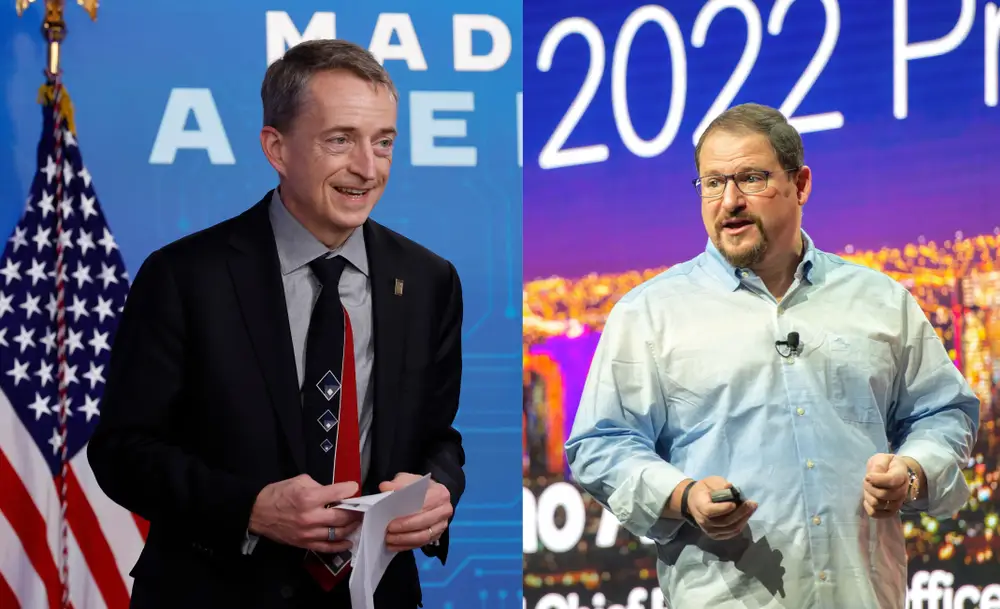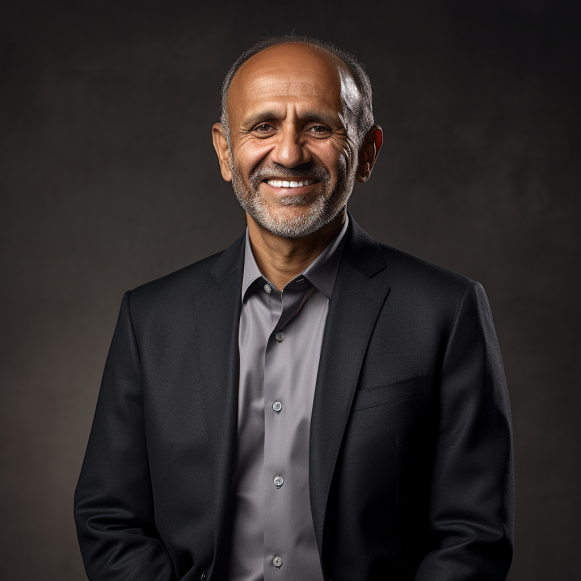Intel and Qualcomm: This ‘odd’ couple won’t solve America’s chipmaking woes

Intel CEO Pat Gelsinger (left) and Qualcomm CEO Cristiano Amon (right)
“Real men have fabs,” AMD cofounder Jerry Sanders once said.
This was back in the late 1980s. The sexist comment needs updating, but his broader point is suddenly very relevant in 2024.
Today, it would be better to say “real countries have fabs.”
A fab is a factory that manufactures semiconductors. These giant facilities require billions of dollars and several years to build. They are incredibly hard to run efficiently.
Intel was the best at this for decades. Then, around 2018, its lead began to crumble, thanks to a series of missteps. TSMC, an upstart from Taiwan, steadily gained and is now unquestionably the best chipmaker in the world.
Bloomberg’s veteran chip reporter Ian King wrote about this in late 2018. Since then, Intel has plummeted and TSMC has soared. Intel is now worth less than $100 billion. It doesn’t even crack the top 150 companies based on this measure. TSMC is worth almost $1 trillion these days, putting it in the top 10.
Why countries must have fabs now
This is an astounding fall from grace for Intel, and a huge strategic and geopolitical problem for the US.
If you want the best chips, you have to go to Taiwan to get them made. Or maybe South Korea, where Samsung has built an impressive so-called foundry business making semiconductors for other companies.
Many of the famous “chipmakers” we think of in the US today don’t actually make chips. Nvidia, Qualcomm, AMD, and all the others design chips, then they usually have TSMC manufacture them. Apple and a host of other big tech giants also have TSMC make the chips they design in-house.
Again, actually producing these complex products at massive scale, with no tiny imperfections, is incredibly hard.
If China invades Taiwan, or somehow exerts much more control over this island nation, this will be a disaster for the US, and Europe for that matter. No more fast iPhones for a while. Nvidia would have to look elsewhere to have its GPUs made. AI progress could stall.
This is why, today, “real countries have fabs” is a better catchphrase. Chips power the modern economy. If you have to get these components overseas, you’re vulnerable.
Qualcomm won’t fix Intel’s worrying decline
This is also why the decline of Intel is so worrying. It’s the only US company that knows how to manufacture powerful chips at scale. (Globalfoundries also makes semiconductors, but not the cutting-edge ones).
The WSJ reported on Friday that Qualcomm approached Intel recently about a deal. That followed a report from Reuters two weeks ago that Qualcomm was considering buying pieces of Intel.
If a deal materializes, it won’t solve America’s chipmaking problem. One analyst called a potential tie-up “odd.”
Qualcomm is probably not interested in Intel’s manufacturing operations. As Reuters reported, it’s keen on some of the chip-design operations.
Intel has 2 main businesses. In one, it designs semiconductors for PCs, data center servers and other uses. The other part manufactures these designs.
For decades, Intel’s design and manufacturing operations were tightly integrated. This worked great for ages. The company could set up its factories to the exact specifications of its in-house chip designers.
Then, the world began to move to a different approach, pioneered by TSMC. Instead of both designing and making your own chips, why not just run the fabs and make chips for other companies?
In the late 1980s, when TSMC got going, this idea was laughed at. (Hence the sexist comment from AMD’s Sanders about real men owning fabs).
But TSMC’s approach gradually caught on, helped by Intel mistakes and the march of modern technology.
The big one happened when Intel missed out on making chips for the iPhone when that revolutionary device was first coming out. Apple ended up going with TSMC. Qualcomm is a huge smartphone chip designer too, and it has TSMC make most of these components. Other chip designers, including AMD, also began turning to TSMC.
This gave TSMC the huge, diverse manufacturing volumes it needed to learn how to make chips better than anyone else. Ian King’s 2018 article describes this virtuous feedback loop well:
With billions of transistors on chips, a problem with a small number of those tiny switches can render the whole component useless. Production runs can take up to six months and involve hundreds of steps requiring maniacal attention to detail. Each time there’s a mistake, the factory operator has a chance to make tweaks and try a new approach. If the change works, that information is retained to try on the next challenge. The more production runs, the better. And TSMC has the most nowadays.
While TSMC was learning from this wide variety of huge customers, Intel’s manufacturing operation was stuck with just one customer: Itself.
As smartphone chips became the biggest game in town, Intel just didn’t have the volume to keep up with TSMC in the manufacturing race. AI has made this situation worse. Nvidia leads here by a mile, and TSMC manufactures its GPUs.
A stubborn manufacturing miasma
Lifting the manufacturing miasma around Intel will be an expensive, risky, and complex effort.
Intel has even begun paying TSMC to make some of its chips. With that as a starting point, there’s a very long way to go.
The US company took a major step recently when it separated its Foundry business from its chip-design business. This makes it easier for outside customers to trust Intel to make their chips without competing against them.
The next challenge is the biggest: Actually being really good at making chips again.
Intel’s Foundry business won’t really be able to challenge TSMC until it gets several big customers. Again, to get good at chip manufacturing you need huge, diverse volumes so you can spot defects, fix processes, and feed that knowledge back into your fabs.
It’s a chicken-and-egg situation. Without big volumes, outside customers will be wary of having Intel make their precious chip designs. But without customers, Intel can’t improve.
Does everyone love Raimondo?
One way to break this deadlock: Get the US government to coax other companies to use Intel’s fabs. This is exactly what’s happening now, according to CNBC.
Commerce Secretary Gina Raimondo has been trying to urge shareholders in companies such as Nvidia and Apple to recognize the economic benefits of having a US foundry that can produce AI chips, CNBC reported recently.
About 4 days later, Intel announced a partnership where it will make an AI chip for Amazon Web Services. Intel stock jumped on the news because AWS is the largest cloud provider and it designs a boatload of chips for use in its huge data centers. This is the type of volume Intel needs.
18A hopes
On the technology side, Intel has a new process node called 18A. This is a set of chip-design rules and an accompanying manufacturing system. If everything goes well in come years, this could make Intel more competitive with TSMC’s leading nodes again.
The AWS partnership is based on this 18A technology, and Microsoft said earlier this year that it will have an in-house chip made on this process node, too.
Intel’s Foundry business just needs way more of these customers. And the 18A technology must work really well for that to happen.
“18A had better be spectacular as they are betting the company on its success,” Bernstein chip analyst Stacy Rasgon wrote in a recent note to investors.
Would a split work?
In the meantime, Qualcomm is unlikely to want to acquire this part of Intel.
This raises the specter of Intel being broken up, something that’s been speculated in recent months. Reuters said Qualcomm is interested in some of the chip-design operations, while the WSJ reported on Friday that Qualcomm would likely sell some parts of Intel to other buyers.
How would Intel’s Foundry business perform as a separate company, split off from the design parts?
The problem here, again, is all about volume. At the moment, Intel’s Foundry business needs the manufacturing volume it gets from the company’s own chip designs. Without that, it would have very little manufacturing to learn from.
“We just don’t see how it could really be done now,” Rasgon wrote in a note in early September. “The manufacturing arm cannot stand on its own right now given heavy losses and lack of scale.”
“A split really only makes sense once it attracts a substantial third party business which seems years away (if ever),” he added.






